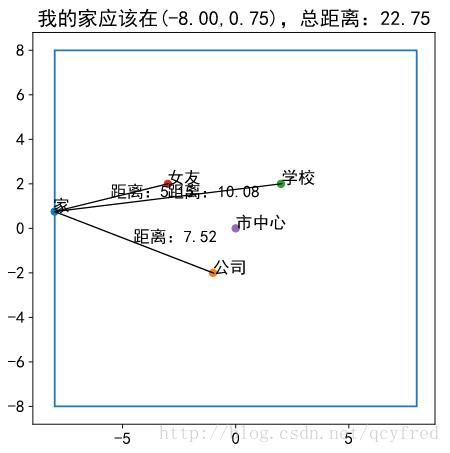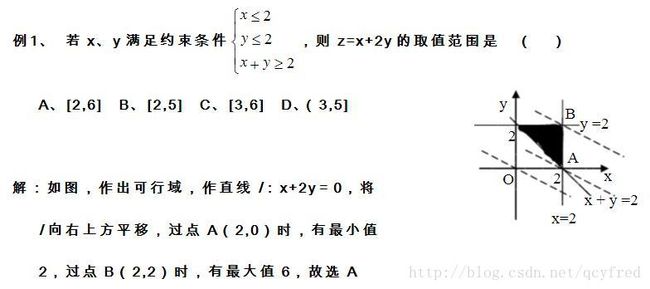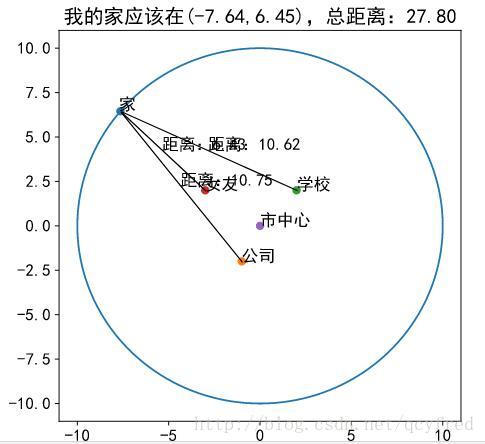Python(22):用SciPy做优化
基本优化问题Demo
和所有的计算机处理问题一样,scipy的optimize其输入也必须规范化。没有规矩,不成方圆。
约束条件
等式类型 g(x) = 0
不等式类型 h(x) >= 0
import numpy as np
import scipy.optimize as sco
def fun_linear(x,flag):
return (x[0] + 2*x[1])*flag
cons = ({'type':'ineq', 'fun':lambda x: -x[0]+2},
{'type':'ineq', 'fun':lambda x: -x[1]+2},
{'type':'ineq', 'fun':lambda x: x[0]+x[1]-2}
)
flags = [-1,1]
for flag in flags:
opt = sco.minimize(fun=fun_linear,x0=[1,1],args=(flag,),constraints=cons)
print(opt['fun']*flag)
6.0
1.99999999999992
都出这个结果了,那我不得不选A了。
求f的最大值相当于求-f的最小值
房子应该租在哪里
百度经验上有这么一道题。
我找到了一份实习,于是想租一个房子,最好离工作近点,但是还没毕业,学校时不时有事,还不能离学校远了;而且有时候还要去女朋友那里,她希望我就住在她附近,于是,我怎么选择房子的地址?
假定公司、学校、女盆友的在地图上的坐标分别是(x1,y1),(x2,y2),(x3,y3)。
求我的房子的坐标。
## 如果预算有限?
约束条件:只能在五环附近租房
1. 五环是个“环”。半径大概10。
2. 五环是个“方”。点到线段的距离大概是8。
假定公司、学校、女盆友的在地图上的坐标分别是(x1,y1),(x2,y2),(x3,y3)。
求我的房子的坐标。
## 如果预算有限?
约束条件:只能在五环附近租房
1. 五环是个“环”。半径大概10。
2. 五环是个“方”。点到线段的距离大概是8。
先引入scipy的optimize
import scipy.optimize as sco
最朴实的距离之和最小
# 生成坐标点
p1 = np.array([-1,-2])
p2 = np.array([2,2])
p3 = np.array([-3,2])
cordinates = [p1,p2,p3]def plot_result(opt, bonds=None):
fig = plt.figure(1,figsize=(6,6))
if bonds == None:
pass
else:
xs,ys = bonds[0],bonds[1]
plt.plot(xs,ys)
offset = 1.01
x,y = (opt['x'][0],opt['x'][1])
plt.scatter(x,y)
plt.text(x*offset,y*offset,'家')
labels = ['公司','学校','女友']
for i in range(len(cordinates)):
c = cordinates[i]
plt.scatter(c[0],c[1])
plt.arrow(x,y, c[0]-x, c[1]-y) # 四个参数分别代表 x,y,dx,dy
plt.text(c[0]*offset,c[1]*offset,labels[i])
plt.text((x+c[0])/2*offset,(y+c[1])/2*offset,'距离:%.2f'%(np.sqrt(sum((opt['x']-c)**2))))
plt.scatter(0,0)
plt.text(0,0,'市中心')
plt.title('我的家应该在(%.2f,%.2f),总距离:%.2f'%(x,y,opt['fun']))
plt.show()# 等权重的距离之和
# 可以考虑在概率意义下的距离之和最短
def calc_total_dist(x, cordinates):
total_dist = 0
for c in cordinates:
tmp = x - c
total_dist += np.sqrt(tmp.dot(tmp))
return total_dist# 求最优解
opt = sco.minimize(fun=calc_total_dist,x0=np.array([0,0]),args=(cordinates))
print(opt)
plot_result(opt)
关于后面几个有约束的问题
添加约束条件就OK
# 求最优解
cons = ({'type':'eq', 'fun': lambda x: x[0]**2 + x[1]**2 - 100})
opt = sco.minimize(fun=calc_total_dist,x0=np.array([10,10]),args=(cordinates),constraints=cons)
print(opt)
# 画出一个环
# 参数方程
t = np.arange(-math.pi, math.pi, 1e-4)
R = 10
xs = 10 * np.cos(t)
ys = 10 * np.sin(t)
bonds = [xs, ys]
plot_result(opt,bonds)
当“五环”不是一个环,而是一个方
这个问题困扰了我一会儿。原因是,一个正方形的曲线的约束方程不好写!
把复杂问题拆成一些简单的问题。4条边不好写,那就在每条边上找一个局部最优解,再在4个局部最优解中找出一个全局最优解。
R = 8
param1 = [0, 1]
param2 = [R, -R]
opt_ress = {}
for k1 in param1:
for k2 in param2:
# 求每条边上的最优解
cons = ({'type':'eq', 'fun': lambda x: x[k1] - k2}#,
#{'type':'eq', 'fun': lambda x: x[1] - R},
#{'type':'eq', 'fun': lambda x: x[0] + R},
#{'type':'eq', 'fun': lambda x: x[1] + R}
)
opt = sco.minimize(fun=calc_total_dist,x0=np.array([0,0]),args=(cordinates),constraints=cons)
# print(opt)
item = {}
item['fun'] = opt['fun']
item['opt'] = opt
opt_ress[(k1,k2)] = item
# print(opt_ress)
min_fun = 1e6
for k,v in opt_ress.items():
opt['fun'] = opt_ress[k]['fun']
if min_fun > opt['fun']:
min_fun = opt['fun']
min_key = k
opt_res = opt_ress[min_key]
home_cord = opt_res['opt']
x1s = np.array([-8,-8,-8,8,8,8,8,-8])
y1s = np.array([-8,8,-8,-8,-8,8,8,8])
bonds = [x1s, y1s]
plot_result(home_cord,bonds)
# min([每条边上的最小的距离])
# 分解复杂问题!!!
# 对numpy.append()和numpy.concatenate()两个函数的运行时间进行比较
# 拼接 np.array
关于绘图,画这个四方形,一条边一条边地画,绕一圈画出来,不然可能会出问题。可能对角线都会被连起来……

